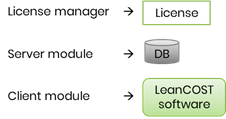LeanCOST Platform architecture
This article describes the LeanCOST platform architecture and provides an overview on license configuration and related installation scenarios.
LeanCOST is a software platform made up of three components:

The following picture shows the relation between them while a description can be found in next chapters.

License manager
License manager is a third-party software component developed by Sentinel Gemalto, a Thales company.
The license is a certificate linked to the single machine which hosts it. It requires a physical or a virtual machine, with client or server operating system, where to install a service. A virtual server can implement dynamic load balancing.
If the host machine needs maintenance, the license can be moved to another machine. The migration needs a specific re-hosting procedure: Hyperlean support will provide the related documentation and will assist you, if needed.
The license can be of two different types:
- Floating (net license): the license is shared among users. The software can be installed on as many computers as you like but the number of available licenses determines the max number of users that can access the software at the same time
- Node-locked: the license is linked to the physical or virtual machine where it’s installed, and it can be used only in that linked machine
The service that allows licenses to work uses the port 1947 (TCP and UDP), registered by Sentinel at IANA. In case of problems, it might be necessary to add firewall exceptions.
For further details about licenses, please visit the provider’s website: https://sentinel.gemalto.com/.
Server module
The server module is composed of two parts:
- a database server that contains LeanCOST database
- one or more shared directories storing LeanCOST output file
Database
All necessary data for LeanCOST is stored in one single database shared among users. The database does not contain files generated by LeanCOST or other structured data types. Its size is limited and only depends on data customization, this means that its size does not increase while using LeanCOST.
The supported platforms are:
- Microsoft Access
It is not necessary to install Office package neither server side nor client side. In this case, you only need a shared folder where administrator users must have full control permissions, while standard users can have only read permissions. - Microsoft SQL (Express, Standard and Enterprise)
The connection to the Microsoft SQL database can be carried out through default TCP port 1433, but you can also choose another one.
During the start-up, it is strongly recommended to use Access to better manage initial customizations that are very common in this phase.
The eventual and subsequent migration to Microsoft SQL platform will be supported by Hyperlean technicians.
Data protection is ensured by LeanCOST architecture. In Microsoft SQL platform, two-step verification validates database’s user identities to better protect both the user’s credentials and the resources the user can access. The authentication string in each client is encrypted with 128-bit Advanced Encryption Standard (AES) algorithm.
For details about database server requirements, please refer to the “System requirements” article.
Output files
As previously mentioned, output files are not stored in the database.
Users can choose one of these options:
- Shared folder: you can set a default folder so each user can use it to save and open files. The path is set in configuration options.
- Local save, in each client machine.
- Connection to corporate PDM/PLM system using LeanCOST PDM module
Client module
The client module is an application developed in Microsoft .NET that allows functions as make new analysis, save/open files, print reports and export structured data. The main prerequisite is Microsoft .NET framework 4.0.
It is distributed through Microsoft Windows self-installing MSI package (you can use third-party service to install and update it in silent mode on a group of machines geographically distributed).
Alternatively, LeanCOST allows the distribution through ClickOnce technology. For more details please refer to “ClickOnce installation” article.
The client also manages the connection to the CAD systems from which LeanCOST imports 3D models and other information. This connection is made by hooking the instance of the active process through the API made available by CAD developers.
If a client PC doesn’t have a CAD system installed, it is possible to import 3D models in LeanCOST through “.step” or “.stp” files, the interchange ISO standard format between different CAD systems.
Authentication
To log in LeanCOST, you should fill in an authentication form. Users and their configurations are stored in a database table.
For each user you should define:
- Associated interface (“Interface”)
- Modules for which he has the license (“ModulesToStart”)
- Dataset on which he can work (strictly related with “LogicId”)
The picture below shows an example of the table.

Authentication can be set with Active Directory profiling LeanCOST users with the same username in Active Directory. In fact, LeanCOST implements Single Sign-On (SSO) scheme using LDAP (Lightweight Directory Access Protocol) and LDAPS (LDAP over SSL).
Integration with CAD systems
LeanCOST interacts with the following CAD systems: Catia, Inventor, Solid Edge, Solid Works, Creo, NX, Tekla and AVEVA.
Thanks to a group of files called ‘interop dll’ provided by Hyperlean S.r.l, LeanCOST connects directly to Catia, Inventor, Solid Edge and Solid Works. CREO requires the installation of PTC module “VB API Toolkit” and to setup specific environment variables, in addition to the ‘interop dll’.
Special approaches:
- NX: the CAD should be installed on client pc, LeanCOST can import the native files without using any ‘interop dll’. The connection is also possible by hooking the instance of the active session (the documentation to enable the import will be provided by the Hyperlean support upon request).
- TEKLA & AVEVA: direct import of native files “.ifc” (for TEKLA) and “.pcf” (AVEVA’s pipe models extension that can be created executing a specific macro).
For additional info, contact support@hyperlean.eu.